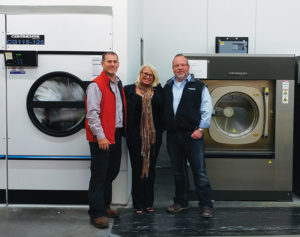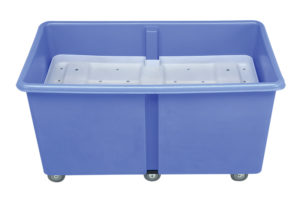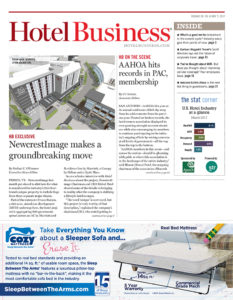PIGEON FORGE, TN—Locating a spot for laundry equipment typically isn’t a problem at a property—unless there are stores at ground level and limited space on the second floor (which spans nearly a quarter of a mile from the lobby to the hallway end). The third floor is also not an option: The penthouse rooms take up the space. With the second floor being the only spot for the laundry in the scenario just described, there are restrictions with what can and cannot be done, especially with equipment type.
“This hotel is actually on an island,” said Kris Harmon, GM of Margaritaville Island Hotel here. “The mountain streams come down off the mountain and split in two small rivers right before the hotel, which creates the island. Thus, the hotel is on concrete pilings and had to overcome an obstacle for stability of the building. This meant that we needed a laundry that would not shake or tear down the existing property situated over the riverside.”
Seeking a solution to its distinctive challenge, the 134-room resort contacted Laundry Systems of Tennessee for assistance—the reason being, the Sevierville, TN-based commercial laundry equipment company has had prior experience with similar challenges. Harmon connected the hotel’s owners with Jeff Large, owner of the laundry company, to design and equip the laundry. “[The company] recommended Continental high-speed soft-mount washers, which we had used before and loved, so it was a ‘no brainer,’” she explained.
When asked why the hotel decided to go with Laundry Systems of Tennessee, Harmon replied, “It was a company that we had used before in our hotel projects with great results.” A distributor should possess two qualities: standing behind the equipment and being available to answer questions or concerns—both of which she saw in the company. “Service was just as important to me as the final decision on equipment,” she said.
The property, which debuted in 2014, is elevated on concrete pilings above a flood plain. Laundry Systems of Tennessee recommended soft-mount washers because, according to its owner, it was the only “option due to the lack of appropriate foundation.” (Soft-mount equipment doesn’t require bolt-down to a concrete foundation.) Processing 20,000 lbs. of hotel laundry per week, the hotel has two 90-lb. capacity soft-mount Continental E-Series Washers; an ozone system; and two 120-lb. capacity Continental Pro-Series II Dryers—all of which were sized, sold and installed by Laundry Systems of Tennessee prior to the facility’s completion.
“The layout of the property is different than most typical hotels with the challenge of the quarter-of-a-mile stretch from lobby to hallway end located on the second floor, which is the only floor with the exception of the penthouse rooms on third,” Harmon explained.
Laundry operations at the property are as follows: Laundry is first gathered throughout the hotel and then brought to the laundry chute; everything is then sorted into specific bins (towels, sheets, blankets, spa linen, etc.) in the laundry room; each type of laundry is then washed separately and placed into the dryers afterward; and then items are taken from the dryers and folded and stored on the large shelves.
After washing and drying the laundry, a third shift sorts the linen into color-coded bags by room type. These bags are then transported back to the second floor storage for “quick turns with stay overs and departures on the following day,” Harmon said.
The property has seen other benefits to using soft-mount equipment, as well. Combining ozone and Continental soft-mount equipment, the laundry is expected to cut $95,000 from overall operating expenses. Together, the soft-mount washers and ozone system cut water, electricity and natural gas costs. “The soft-mount washers offer superior efficiency in combination with high extra speeds reaching 400 g-force,” Large said. “The extra-high speeds remove more moisture from every load of laundry, which in turn, shortens the drying process. E-Series Washers cut dry time by up to 50% when compared with most hard-mount washers, which max out at approximately 200 g-force. By shortening dry time, the hotel uses less energy and natural gas, while boosting laundry productivity throughout.” (Reducing dry time also extends the longevity of dryers.)
Injecting ozone gas into the wash cycle helps break down organic material and relaxes fabric fibers—in addition to sanitizing laundry and killing bacteria. “Finally, ozone helps shorten the wash cycle because it can eliminate the prewash cycle,” Large said. “This makes it so the washers complete cycles more quickly and use less water.”
Due to the soft-mount equipment, linens are lasting longer. “Thanks to the soft-mount washers, laundry productivity escalates, gas usage falls, and linens and towels are subject to significantly less tumbling action, and wear-and-tear,” Harmon said. HB
Spring-loaded laundry carts: What you need to know
NATIONAL REPORT—The topic of laundry operations in the hotel industry is more often than not focused on how a property can save time and money and, most importantly, prevent unwanted injuries. While each of these areas are worth discussing—especially for hotels with laundry operations on site—the understanding of products and various design types can help better inform those in charge of purchasing laundry products. That being said, not all laundry carts are created equal; they’re manufactured in various shapes, sizes and materials. One consideration when examining laundry carts: whether the product is spring-loaded or not.
What makes a laundry cart a spring-loaded solution? A simple platform with a spring mechanism underneath. “When laundry is placed in the cart, the platform sinks into the cart—sinking lower and lower as more and more laundry is placed in the cart,” explained Dan Rodriguez, a national sales manager at MODRoto—a Madison, IN-based designer and manufacturer of rotomolded plastic products for the laundry industry. “When laundry is removed, the platform automatically rises.”
Designed to reduce the need for workers to bend and reach into the bottom of the cart, this product type “can make everybody’s job a little easier and also reduce the risk of worker injuries,” said Gabriel Mandujano, founder and CEO of Wash Cycle Laundry, a Philadelphia-based laundry and linen solutions company for the hospitality industry. Spring-loaded carts are also designed to boost productivity in a hotel’s laundry room.
Spring-loaded laundry carts are typically available in two different designs. The major difference between the two cart types is the platform. Some carts have “platforms that hang via springs that are looped around the rim of the container and platforms that are supported from underneath by large coils,” Mandujano explained. There are times where one design type is preferred over the other. For example, Wash Cycle Laundry opened a new on-premise laundry in a Hilton property last year. “We fitted out all our finishing carts with the ‘hanging’ spring lifts, and we thought that design fell short,” he said. “With design, it’s relatively easy for small pieces like pillowcases or tablecloths to get stuck below the platform, and the hanging springs tend to get in the way. It’s also easy for front-line operators to remove the platform entirely, and some people did because they thought the platform got in the way more than it helped.”
Springs for spring-loaded laundry carts are manufactured in a variety of load rates (the amount of weight a spring is designed to carry when deflected to a certain height) and spring rates (the amount of weight needed to compress a spring one inch). “To specify the right spring for an ergonomic cart, we take a look at how much weight the platform needs to bear during typical usage (delivering clean sheets and towels for example) and also how much weight it might have to bear during occasional or extreme usage, such as catching soiled laundry from a chute system,” Rodriguez said. “Using a smaller spring is preferable since it leaves more room above the platform for holding laundry.”
In addition to evaluating platform design and spring varieties, assessing the container itself is just as important. One question to ask: What type of siding do the carts have? “Lots of vendors will market spring lifts on ‘basket’ carts that have vinyl or canvas siding and a wire metal frame,” Mandujano explained. “Over time, we found that those baskets get bent out of shape, which in turn makes the spring platform get stuck. Of our original order of spring lift carts, only one is still in operation about one year on.”
— CJ Arlotta



